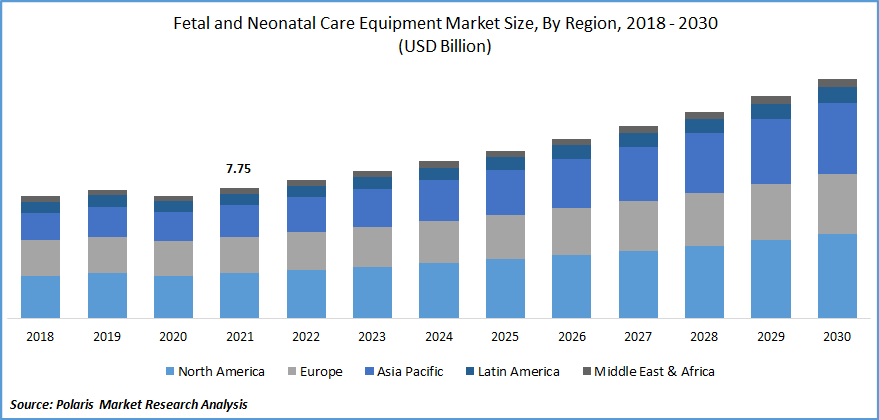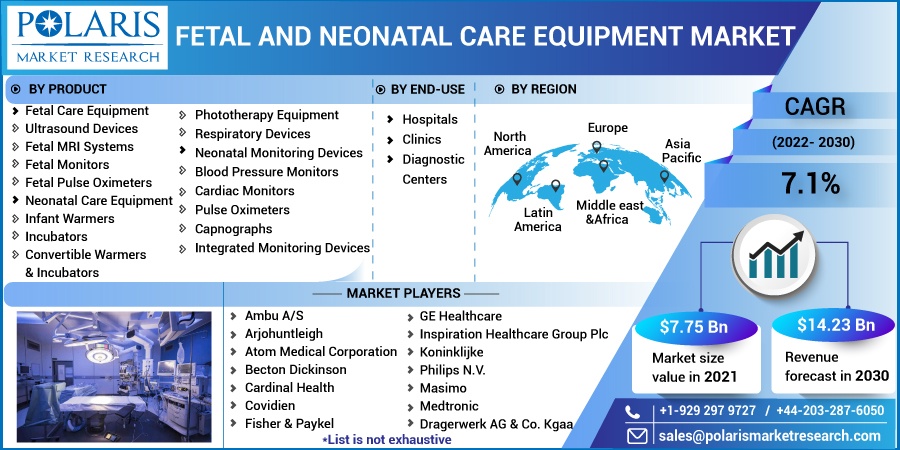
Fetal and Neonatal Care Equipment Market Share, Size, Trends, Industry Analysis Report, By Product (Fetal care Equipment, Neonatal Care Equipment); By End-Use; By Region; Segment Forecast, 2022 - 2030
- Published Date:Sep-2022
- Pages: 114
- Format: PDF
- Report ID: PM2602
- Base Year: 2021
- Historical Data: 2018-2020
Report Outlook
The global fetal and neonatal care equipment market was valued at USD 7.75 billion in 2021 and is expected to grow at a CAGR of 7.1% during the forecast period. The growing demand for fetal and neonatal care equipment market is expected to be driven by the increasing birth rates across many developing countries, rising preterm birth rates, and many government initiatives to create awareness about infant health.

Know more about this report: Request for sample pages
The demand for neonatal equipment is increasing at high birth rates, and public and private organizations making efforts to spread awareness about the equipment for newborns' health across rural and urban regions is the major factor driving the growth of the market, which eventually increases the sales of the devices. Furthermore, the growing rates of hospital-acquired infections in neonates and the availability of many NICUs across rural and urban areas focusing on maternal and child health are expected to have a positive impact on the market growth.
The COVID-19 pandemic has hampered the growth of the fetal and neonatal care equipment market. The economic slowdown and negligible operations have reported a sharp decline in neonatal and fetal devices. Moreover, due to the rise, the infection led to fear among hospitals and infant care centers of spreading the infection, which resulted in shutting down clinics and hospitals, which resulted in few admissions of neonatal patients.
However, as the activities resumed, the increased demand for fetal and neonatal devices was observed as it was convenient to use the devices in the home, which drove the market growth. The advancement in technologies to monitor maternal and fetal care and the development of devices that are lightweight and cost-efficient are likely to complement the market growth over the forecast period. In addition, the growing number of premature births with low birth weight and low immunity has created a lucrative opportunity to develop new innovative devices which will support the market growth over the forecast period.
 Know more about this report: Request for sample pages
Know more about this report: Request for sample pages
Industry Dynamics
Growth Drivers
The global fetal and neonatal care equipment is likely to be driven by the demand in the Asia Pacific owing to the increasing number of preterm birth and unhealthy babies across many regions of Asia Pacific. Furthermore, the challenges because of genetic changes and changes in lifestyle result in unhealthy and underweight babies, which eventually raise the demand for fetal and neonatal care equipment market.
Moreover, government initiatives and policies to reduce the infant mortality rate are also contributing to market growth. In addition, the rise in the need for well-performing equipment to monitor the premature infant is the major factor contributing to the market growth.
Report Segmentation
The market is primarily segmented based on product, end-use, and region.
|
By Product |
By End-Use |
By Region |
|
|
|
Know more about this report: Request for sample pages
Fetal Care segment accounted for the largest share in 2021
The fetal care equipment segment accounted for the highest revenue share in 2021 owing to advancements in technology and increased awareness among individuals is driving the growth of the market. The sub-segment ultrasound devices have dominated and are expected to grow over the forecast period owing to the application of observing fetuses during stages of pregnancy. In addition, advanced devices such as portable ultrasound devices could be operated in-house, which is increasing the demand for the equipment segment.
Neonatal care equipment is also expected to grow over the forecast period owing to ease of availability and the convenience with which it could be used at home. Moreover, the respiratory devices segment is expected to grow and would continue to dominate the market as rising respiratory problems among infants. Demand for neonatal ventilators is growing to shorten hospital stays and reduce the risk of long-term disability, which is expected to grow over the forecast period.
Hospitals segment is expected to account for the largest share in 2030
The hospital segment is expected to dominate the market over the forecast period owing to the increasing adoption of fetal and neonatal care equipment across developed and developing countries. The advancement in technologies and availability of professionals to improve patient care are driving the growth of the market. Furthermore, increasing numbers of NICUs in hospitals and rising number of patients are boosting the growth of this segment.
Clinics are expected to be one of the other significant segments of the fetal and neonatal care equipment market, which is anticipated to grow in the market. The rising demand for clinics across developing countries such as India, China, and Nigeria owing to rapid diagnosis and effective care through specialized care and specialty clinics is accelerating the demand. Moreover, the demand for clinics usually rises as bigger facilities are not available to meet the needs of the consumer, which is one of the factors to drive the market growth.
North America is expected to dominate and witness fastest growth over the forecast period
North America is the largest region for fetal and neonatal care equipment. It is expected to witness faster growth over the forecast period owing to the majority of the region having a high preterm birth rate along with the presence of excellent reimbursement structures, which drives the growth of the market. Moreover, advanced products which ensure improved healthcare facilities and lifestyle challenges are some of the factors that support the growth of the segment.
Asia Pacific is expected to be the second largest region for fetal and neonatal care equipment on account of the growing initiatives taken by the government and awareness about newborn health and care. Furthermore, increasing birth rates among developing countries and the manufacturing of many fetal and neonatal equipment across the regions, including incubators, infant warmers, and ultrasound systems, are expected to boost the segment.
Competitive Insight
Some of the major players operating in the global market Include Ambu A/S, Arjohuntleigh, Atom Medical Corporation, Becton Dickinson, Cardinal Health, Covidien, Dragerwerk AG & Co. Kgaa, Fisher & Paykel Healthcare Limited, GE Healthcare, Inspiration Healthcare Group Plc, Koninklijke, Philips N.V., Masimo, Medtronic, Natus Medical Incorporated, Phoenix Medical Systems, Smiths Medical, Spacelabs Healthcare, Utah Medical Products and Vyaire Medical Inc.
Fetal and Neonatal Care Equipment Market Report Scope
|
Report Attributes |
Details |
|
Market size value in 2021 |
USD 7.75 billion |
|
Revenue forecast in 2030 |
USD 14.23 billion |
|
CAGR |
7.1% from 2022 - 2030 |
|
Base year |
2021 |
|
Historical data |
2018 - 2020 |
|
Forecast period |
2022 - 2030 |
|
Quantitative units |
Revenue in USD billion and CAGR from 2022 to 2030 |
|
Segments covered |
By Product, By End-Use, By Region |
|
Regional scope |
North America, Europe, Asia Pacific, Latin America; Middle East & Africa |
|
Key companies |
Ambu A/S, Arjohuntleigh, Atom Medical Corporation, Becton Dickinson, Cardinal Health, Covidien, Dragerwerk AG & Co. Kgaa, Fisher & Paykel Healthcare Limited, GE Healthcare, Inspiration Healthcare Group Plc, Koninklijke, Philips N.V., Masimo, Medtronic, Natus Medical Incorporated, Phoenix Medical Systems, Smiths Medical, Spacelabs Healthcare, Utah Medical Products and Vyaire Medical Inc. |
